Wat Arun is definitely one of the most beautiful temples in Bangkok. Its architecture, the pretty decorations and the unique location next to the river make this temple a must-see temple in this city.
History of Wat Arun
This is the oldest temple in Bangkok, located on the west bank of the Chao Phraya River. Wat Arun actually has a longer name, Wat Arun Ratchawararam Ratchaworamahawihan. The temple was built during the Ayutthaya Dynasty in the early 17th century. When King Thaksin decided to build a new capital in Thonburi, he came here at dawn. The temple is named after the Hindu God Aruna, symbolized as the rising sun.
The temple housed the Emerald Buddha before it was moved to Wat Phra Kaew on the east bank of the river in 1785. It stood on the grounds of the royal palace during Taksin’s reign, before his successor, Rama I (1782–1809), moved the palace to the other side of the river. Later, under King Rama II, this temple underwent another major renovation. In 1980, Wat Arun was recognized as a UNESCO World Cultural Heritage. Nowadays, this temple is still honored as one of the largest Buddhist temples in Bangkok, attracting many visitors to visit every year.
Looking to experience the best of Thailand in a short time? Dive into this 12-day trip to Thailand’s highlights and uncover the perfect blend of culture, nature, and adventure across the country’s most iconic destinations.
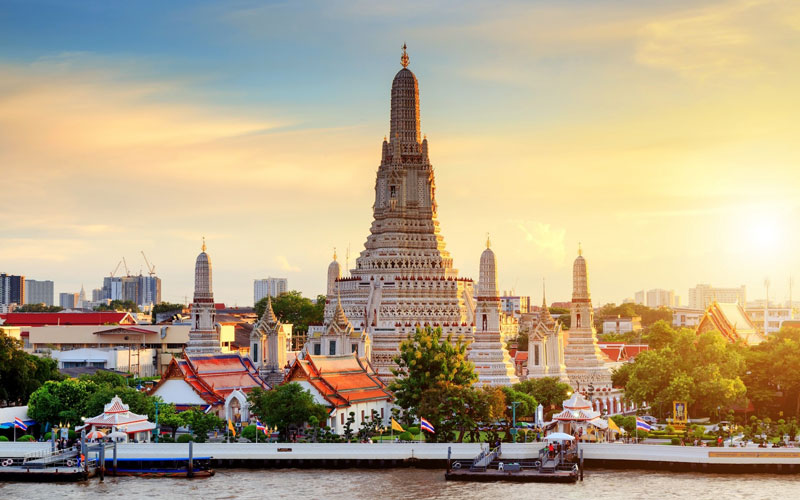
The charming Wat Arun
Opening Hours and Ticket Cost
Address: 158 Thanon Wang Doem, Wat Arun, Bangkok, Thailand
Opening hours: 8 AM – 6 PM daily, the last entrance is at 5:30 PM.
Entry fee:
- Adult: 100 Baht per one
- Children: Children under 120cm are usually free or discounted, but you should check specifically at the ticket office.
Some special areas such as the main tower (Prang) may have additional entrance fees, so you should be prepared to pay extra if you want to explore the entire temple. Check for any updates on entry fees before planning your visit because prices may vary over time. You can check via the official website of Wat Arun.
How to Get to Wat Arun
Wat Arun is easily accessible by a variety of means of transport. The most popular and scenic way to get to the temple is by boat across the Chao Phraya River. You can catch a boat from several piers along the river. Here are some options:
- By Boat: Take a boat from Sathorn Pier (connected to Saphan Taksin BTS Station). The Chao Phraya Express Boat will take you directly to the temple.
- By BTS and Boat: Take the BTS Skytrain to Saphan Taksin Station and then take the Chao Phraya Express Boat from Sathorn Pier.
- By Taxi or Tuk-Tuk: Although you can be stuck in traffic, taxis and tuk-tuks are a direct and convenient way to get to this temple from most locations in Bangkok. Be sure to check the traffic conditions beforehand, especially during peak hours to avoid being delayed.
The easiest route is to get the train to Sanam Chai MRT Station and walk to Tha Tien Express Boat Pier. The ferry will take you to the other side of the Chao Phraya River, from where you can walk to the temple.
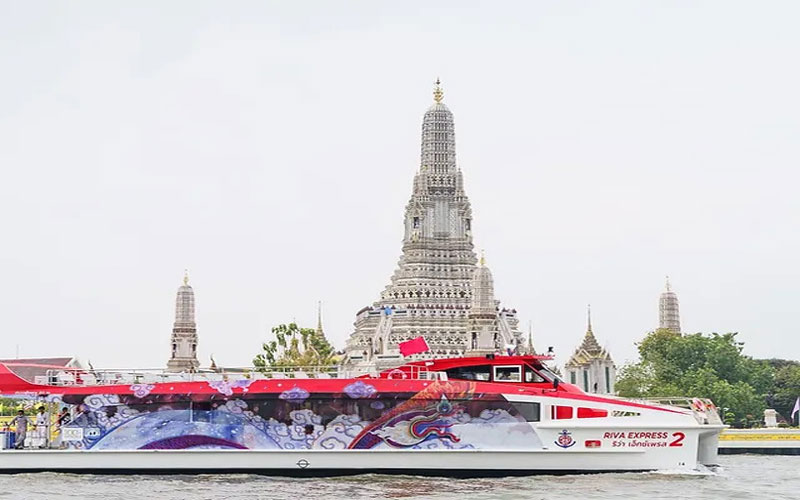
Chao Phraya Express Boat
What to See in Wat Arun
The Entrance of the Ordination Hall
A particularly great place to take spectacular images is the famous archway with the crown, which is the entrance to the Ubosot. The entrance to the ordination hall of the temple is guarded by two demon figures. These towering giant figures – the Yakshas are decorated in elaborate and brilliant designs, providing access to the ordination of the monks. Admire the mural paintings inside the hall narrating the chronicles of Lord Buddha’s life.
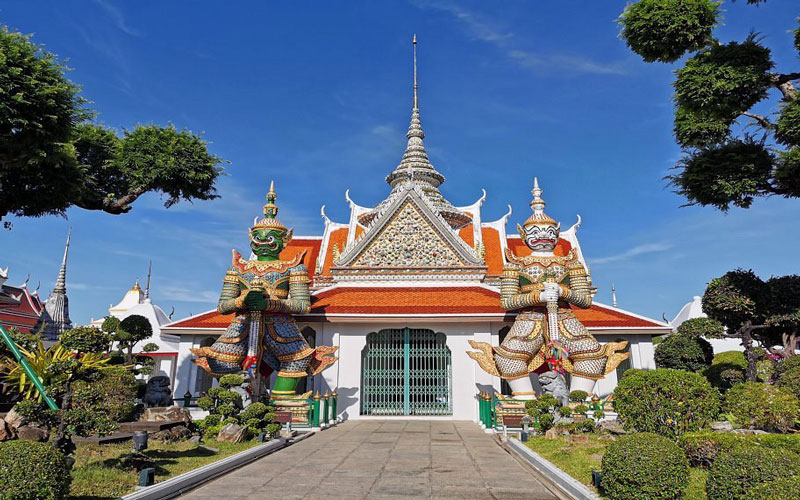
the entrance to the Ubosot
The Main Hall
The main hall, or Ubosot, is considered the holiest part of Wat Arun. It is used for prayer and significant ceremonies. Located slightly behind the central prang, this hall represents traditional Thai temple architecture with a large, steeply sloped roof adorned with intricate decorations. The colorful tiles and decorative peaks on the roof add to the beauty and spiritual atmosphere of the hall. Another highlight of the hall is the marble courtyard. Many Chinese stone sculptures depict lions, dragons, warriors and other mystical figures.
Inside the Ubosot, visitors can find a revered Buddha statue crafted in gold, designed by King Rama II. The walls inside the hall are decorated with beautiful murals depicting the life of Buddha and important moments in Thai history.
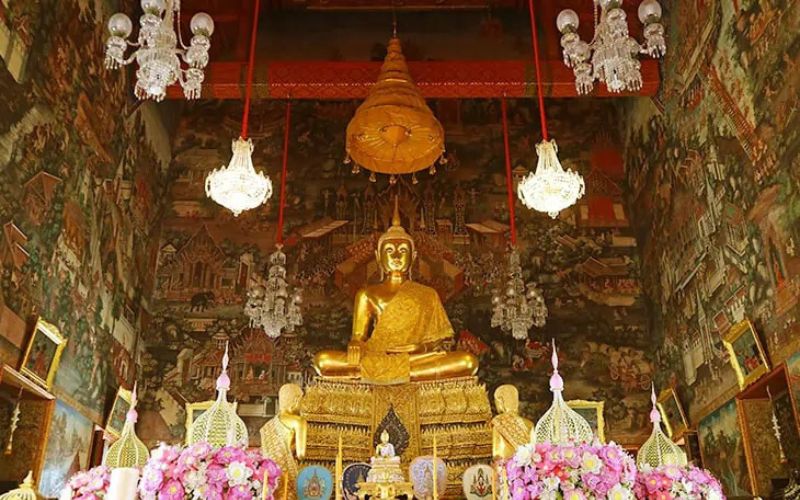
the golden Buddha statue inside the main hall
Tower Phra Prang
Wat Arun is famous for its beautiful Phra Prang. It is the central tower of the temple with a spire-like structure that’s about 79 meters tall and surrounded by four smaller prangs at each corner. It symbolizes Mount Meru, the center of the universe in Buddhist cosmology. Decorated with seashells and colorful porcelain tiles, the Phra Prang reflects sunlight beautifully, especially at dawn and dusk.
Even from a distance, you can still see it shining brightly in the sun. Visitors can climb part of Phra Prang via stairs to enjoy panoramic views of the Chao Phraya River and the Bangkok skyline. This central tower is not only a visual wonder but also has deep religious significance.
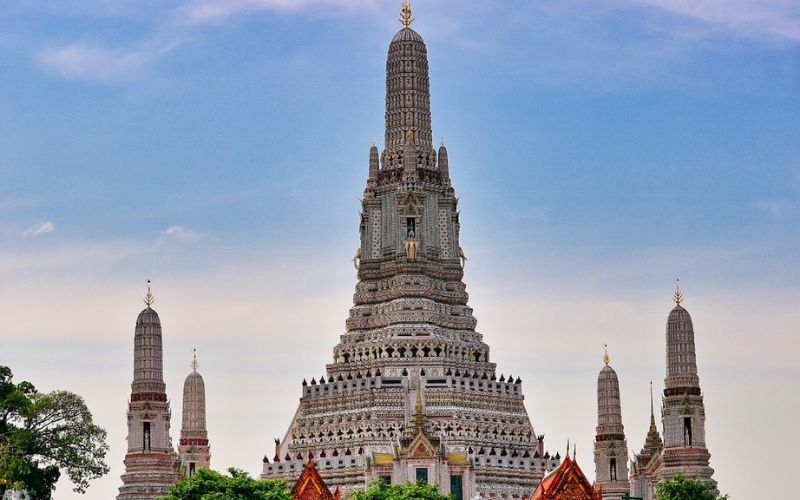
Phra Prang in Wat Arun
Sunset at Wat Arun
Sunset at Wat Arun is a breathtaking experience, as the temple’s silhouette against the setting sun creates a magical scene. The colors change from amber to pink and purple, creating a serene and picturesque scene. As the sun sets lower, the temple’s lights brighten, highlighting the architecture and casting a sparkling glow across the water.
Make sure to get to the East Bank of the Chao Phraya River at least 1 hour before sunset time to find the best spot to take photographs of the temple. On the other side of the river, you will find several rooftop bars from where you can admire the best view of the temple.
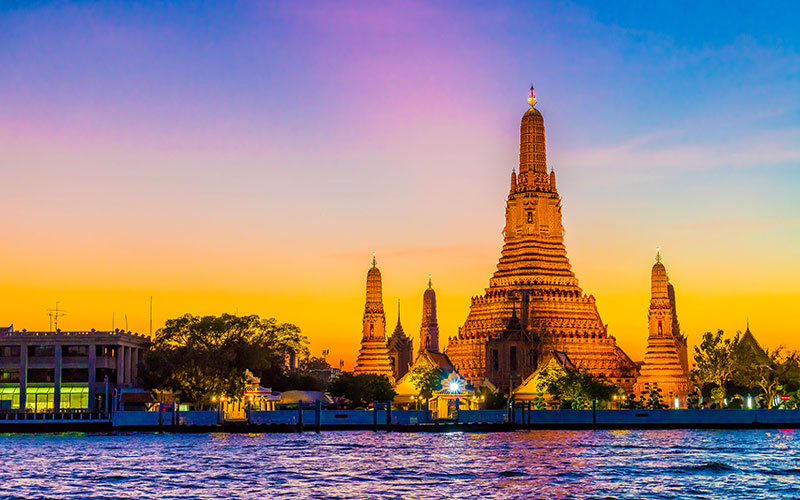
Wat Arun at dusk
Photography Tips When Visiting Wat Arun
Wat Arun is one of the best places to take photos in Bangkok, especially at sunrise and sunset when the light highlights the intricate details of the temple. For the most impressive photos, here are some tips:
Shoot a panoramic photo from the riverbank
Since it is a tall and spacious structure, you can use a wide-angle lens to capture the entire architecture of the temple in one frame. This allows you to capture both the main tower and the surrounding sub-towers without losing any details. One of the best angles to take photos is from the opposite bank of the river, especially at sunset. From here, you can capture the entire temple with the golden-orange light of the afternoon sun reflecting off the surface of the tower.
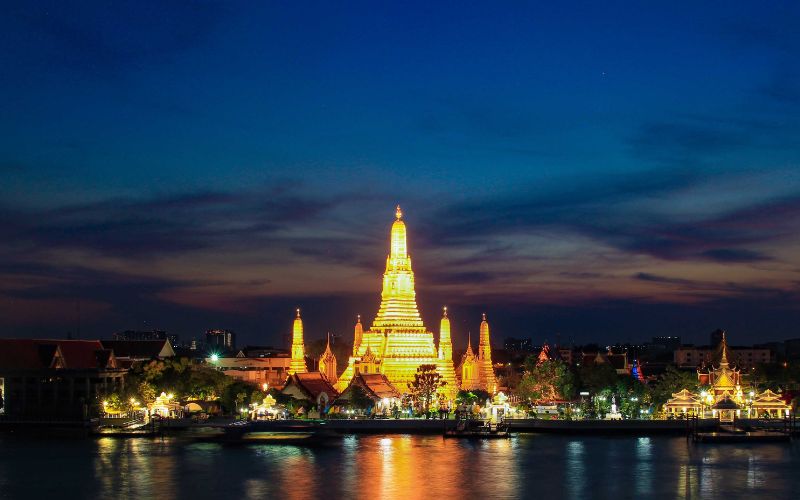
a panoramic photo of Wat Arun
Shoot a sunrise and sunset
Wat Arun is known as the “Temple of the Dawn”, so sunrise is when the morning light gently illuminates the temple, creating a peaceful atmosphere. Sunset is also a great time when the golden-orange light bathes Wat Arun in a golden-orange light. If you want to take a dramatic photo with beautiful light, plan to visit the temple during these two times.
Unique angles
If you want a unique and different angle, you can try shooting from the inner walkways of the temple, which offers a panoramic view of the Phra Prang. The central Phra Prang is the highlight of Wat Arun, with its unique architecture and colorful ceramic decorations. To capture this beauty, take close-ups of the ceramic mosaics and guardian statues, as these are unique highlights of Wat Arun’s architecture. You can also shoot from a lower angle to highlight the height of the tower.
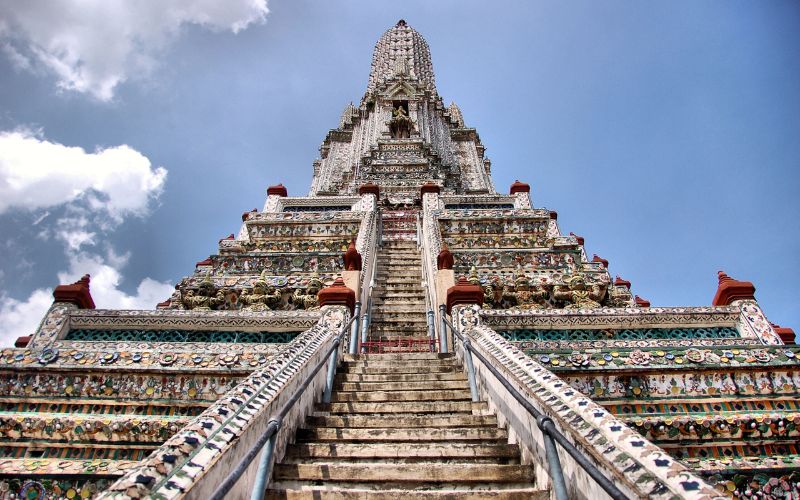
Phra Prang from a lower angle
Notes on photographing locals and monks
When taking photos, be careful and respectful of the sacred space of the temple. Do not take photos of people praying or monks without permission. This not only helps you respect the local culture but also ensures a complete and meaningful visit.
Tips For Your Trip to Wat Arun
Here are some helpful tips to make the most of your visit to Wat Arun:
- The best time to visit is early in the morning, close to opening hours. You can comfortably visit the temple before the crowds arrive. Alternatively, a visit at sunset is also an impressive experience. You can go around at 5 PM to admire Wat Arun in the sunset, creating the most magical moment. However, the temple complex closes at around 6 PM.
- Dress modestly: Make sure your shoulders and knees are covered to respect Thai cultural customs. You can rent clothing on-site if you are not dressed appropriately. Rentals are free but require a deposit and there are often longer lines. When entering a temple, take off your shoes as a sign of respect.
- Respect photography rules: While photography is generally permitted, avoid using flash or taking photos in areas where it is prohibited. For panoramic shots, you can photograph from the riverside or higher spots within the temple grounds.
- Remain silent: Wat Arun is a place of worship, please remain silent to respect those who come to pray.
- The central Phra Prang has very steep stairs. If you plan to climb, wear comfortable shoes, and be cautious on the steps because they can be narrow and challenging.
Visiting Wat Arun is a unique and unforgettable experience, offering a blend of cultural, historical and spiritual insights into Thai heritage. Whether you are captivated by the spectacular sunrises, the intricate porcelain mosaics of the Phra Prang or the serene riverside scenery, Wat Arun represents the beauty and reverence of Thailand’s rich traditions. By planning your visit carefully and respecting local customs, you will be able to fully admire this iconic landmark.

